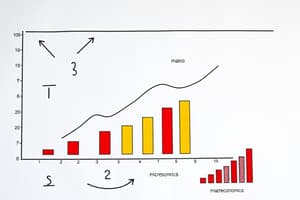Podcast
Questions and Answers
What is the primary focus of microeconomics?
What is the primary focus of microeconomics?
- Exploring the global economic systems
- Investigating the government's fiscal policies
- Studying the decision-making of individuals and businesses (correct)
- Analyzing the behavior of entire nations
Which concept in microeconomics describes the interaction between consumers' desires and firms' abilities to produce and sell goods?
Which concept in microeconomics describes the interaction between consumers' desires and firms' abilities to produce and sell goods?
- Comparative advantage
- Price elasticity of demand
- Marginal utility
- Economies of scale (correct)
What is a central principle of perfect competition in microeconomics?
What is a central principle of perfect competition in microeconomics?
- Limited product differentiation among sellers (correct)
- Few sellers and buyers with significant market power
- High barriers to entry for new firms
- Government intervention through price controls
In microeconomics, what represents a market structure where each firm has a unique product and some degree of market power?
In microeconomics, what represents a market structure where each firm has a unique product and some degree of market power?
How does microeconomics differ from macroeconomics?
How does microeconomics differ from macroeconomics?
Which market structure is characterized by a small number of firms capable of influencing market prices?
Which market structure is characterized by a small number of firms capable of influencing market prices?
What is the formal model of consumer behavior that suggests individuals seek to maximize their satisfaction from consuming goods and services?
What is the formal model of consumer behavior that suggests individuals seek to maximize their satisfaction from consuming goods and services?
What economic principle represents the total demand for goods and services in an economy, including consumer spending, investment, government spending, and net exports?
What economic principle represents the total demand for goods and services in an economy, including consumer spending, investment, government spending, and net exports?
Which concept illustrates the flow of income and expenditure between producers and consumers in an economy?
Which concept illustrates the flow of income and expenditure between producers and consumers in an economy?
What term refers to the fluctuation of an economy's output over time, characterized by periods of expansion and contraction?
What term refers to the fluctuation of an economy's output over time, characterized by periods of expansion and contraction?
Study Notes
Understanding Economics: Micro and Macro Perspectives
When we delve into the fascinating world of economics, we encounter two primary lenses through which we examine the behavior of individuals, businesses, and entire nations. These lenses are microeconomics and macroeconomics—two complementary, but distinct, approaches to understanding economic systems.
Microeconomics: Understanding the Decision-Making of Individuals and Businesses
Microeconomics is the branch of economics that focuses on the behavior of individual entities—such as consumers, firms, and households—and the interactions between them. This perspective sheds light on the microfoundations of an economy: the specific decisions people make and how they influence one another.
A central concept in microeconomics is the idea of supply and demand, which describes the interaction between consumers' desires and firms' abilities to produce and sell goods and services. Other key microeconomic principles include:
- Economies of scale: The ability of a firm to reduce the per-unit cost of production as the output level increases.
- Perfect competition: An idealized market structure in which there are many sellers and buyers, and each holds negligible market power.
- Monopolistic competition: A market structure characterized by numerous firms, each with a unique product and some degree of market power.
- Oligopoly: A market structure characterized by a small number of firms, each capable of influencing market prices.
- Utility theory: A formal model of consumer behavior, which posits that individuals seek to maximize their satisfaction or "utility" from consuming goods and services.
- Cost theory: A model of firm behavior, which posits that firms seek to maximize their profits by minimizing costs and maximizing revenue.
Macroeconomics: Investigating the Behavior of Nations and Economies
Macroeconomics is the branch of economics that focuses on the behavior of entire economies and nations. In contrast to microeconomics, which studies the behavior of individual entities, macroeconomics studies the behavior of large aggregates, such as gross domestic product (GDP), unemployment, inflation, and interest rates.
Some key macroeconomic principles and concepts include:
- Aggregate demand: The total demand for goods and services in an economy, comprised of consumer spending, investment, government spending, and net exports.
- Aggregate supply: The total supply of goods and services in an economy, which is influenced by factors such as resource availability, technology, and the price level.
- The circular flow of income: A model that illustrates the flow of income and expenditure between producers and consumers in an economy.
- The multiplier effect: The principle that an increase in spending will lead to a larger increase in total income, due to the amplifying effect of interdependent spending and income.
- The Phillips curve: A historical representation of the relationship between unemployment and inflation, showing that lower unemployment is generally associated with higher inflation.
- Fiscal policy: The use of government spending and taxation to influence an economy's performance.
- Monetary policy: The use of interest rates and the money supply to influence an economy's performance.
- Business cycle: The fluctuation of an economy's output over time, characterized by periods of expansion (growth) and contraction (recession).
Both microeconomics and macroeconomics are interconnected and mutually enriching. For instance, microeconomic principles such as supply and demand inform macroeconomic models of aggregate demand and supply, while macroeconomic concepts such as business cycles influence microeconomic theories of expectation formation and adaptive behavior.
In summary, whether we are analyzing individual consumers, firms, or entire nations, understanding economics requires a nuanced appreciation for microeconomics and macroeconomics. By studying these two distinct but interconnected perspectives, we deepen our understanding of the complexities of economic behavior and the intricate relationships that shape our world.
Studying That Suits You
Use AI to generate personalized quizzes and flashcards to suit your learning preferences.
Description
Test your knowledge on the fundamental differences between microeconomics and macroeconomics, exploring concepts such as supply and demand, aggregate demand, fiscal policy, and more. Understand how these two branches of economics offer unique perspectives on individual behaviors and entire economies.




